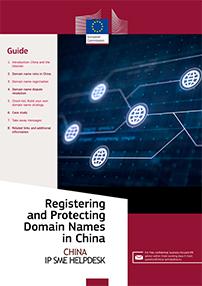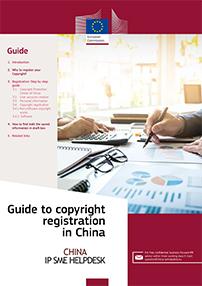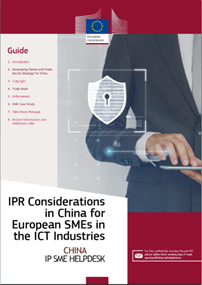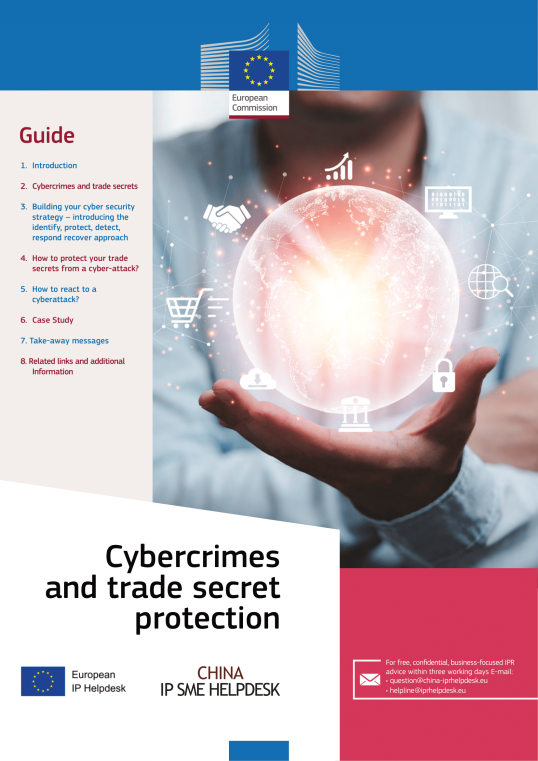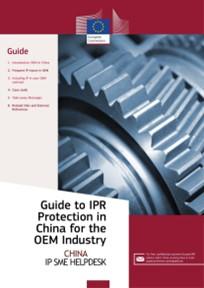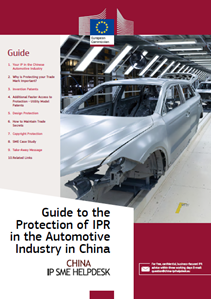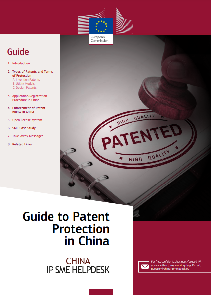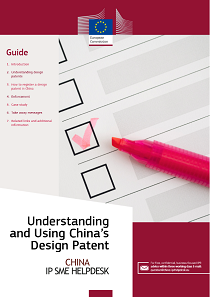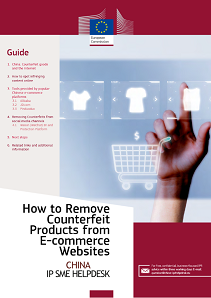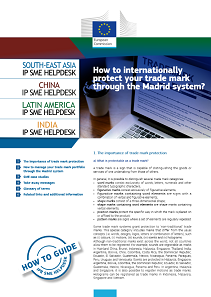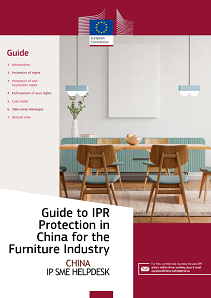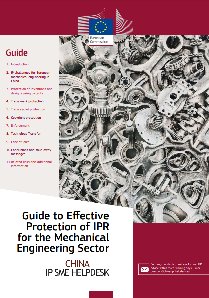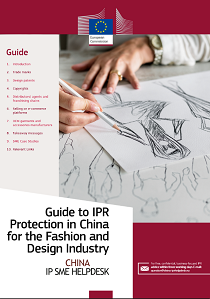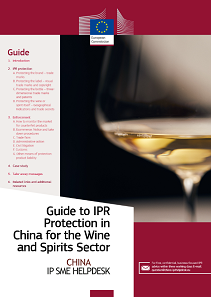IP Guides
The following Helpdesk publications provide a range of expert-written guides that assist businesses in understanding the IP landscape in China.
IP Guide listing
|
|
|
Registering and protecting domain names in China Your domain name often represents the first point of contact between you and your customers: it conveys your brand reputation and acts as the main online access point to product and contact information and, often, for sales. As such, having control over your first choice domain name is the initial, and most important step in managing your online presence. Loss of your domain name can easily lead to consumer confusion, lost web traffic and emails, and it can also result in loss of reputation and lost business. The omnipresent nature of the Internet means that even EU SMEs operating exclusively in their home markets cannot ignore the risks that domain name infringement may pose to their business, even if these activities originate in China. |
|
|
Guide for IPR Protection in the medical device industry in China While China is a focus of attention for the healthcare industry as one of the world’s largest and fastest developing markets, a chief concern for the medical device industry is the risk of IPR infringement. This guide takes a practical look at IPR protection and enforcement in China with a particular focus on issues facing SMEs in the medical device industry. The guide examines registration of IPR, managing IP through R&D and sourcing, and enforcement. |
|
|
|
Guide for IPR Protection in China for the Pharmaceutical Industry China’s pharmaceutical market has seen continuous growth in the past 10 years, becoming the world’s second largest market for pharmaceuticals. Supported by the governmental reforms and measures to encourage cost control integration and innovation as well as by China’s ambitions of bringing the health care sector to the forefront of biopharmaceutical and digital innovation, China’s pharmaceutical market offers many opportunities to European enterprises. Pharmaceutical production is a research and development (R&D) driven industry. The potential and profit of pharmaceutical companies are very dependent on the adequate protection of Intellectual Property Rights (IPR). IP is the most effective way to protect R&D and is a powerful weapon to use in the pharmaceutical market in China. This guide focuses on the principal IPR issues/provisions in the field of pharmaceuticals, namely in the areas of patent, trade mark, copyright, and technical secrets. |
|
|
|
How to file a copyright registration in China Copyright protects original creative expressions of ideas that subsist in a fixed medium such as on a piece of paper, on an artist’s canvas, on a disc, or on magnetically recordable media. Copyrightable expressions are known as “works”. Ideas include thoughts, feelings, procedures, methods of operation, or mathematical concepts, and other products of creative and intellectual endeavours. Copyright protects only the expression of an idea, not the idea itself. For example, your detailed written description about your company’s new and innovative Internet business model in your business proposal to potential investors is protectable by copyright as an expression, but the Internet business model itself and the ideas, concepts and principles behind it are not protectable by copyright. You can use other types of intellectual property rights (IPRs) to protect your ideas. Copyright is a form of intellectual property that protects a creator’s exclusive right to control who reproduces or alters the product of their original creative effort. Copyright protects the producers of any original work, and is relevant to almost all businesses, not just those in the creative industry. Adequate copyright protection can form an important part of your IPR protection strategy. Your business may regularly create articles, photographs, drawings, designs, models, websites, computer software, etc., which all enjoy copyright protection. Copyright is an automatic right that arises the moment you create an original work. Once an original work is created, in most cases, the creator will automatically enjoy copyright protection in all 178 member countries of the Berne Convention for the Protection of Literary and Artistic Works including all European Union countries and China. Though your original work is automatically protected by copyright the moment it is created, it is advisable to apply for a voluntary registration to provide proof of your ownership of the copyright, which can save you time and money in case of a dispute later. Registration is particularly important for copyrights that are essential to the livelihood of your business (i.e., website, software, catalogue, customer database, etc.).. |
|
|
|
Guide to IPR Protection in China for the Textile Industry China’s textile industry is both an opportunity and threat to European businesses. It is a major market for those supplying production technologies and a key supply base for textiles and finished goods. In recent years, China has also become a lucrative market for textile products due to increasing disposable income of its citizens. However, foreign technologies and brands that are not adequately protected often fall victim to infringement by Chinese competitors. This guide addresses IP issues across subsectors of the textile industry, including textile machinery, yarns and specialty fabrics, finished fabrics and brand apparel & accessories. The areas of IP most relevant to the above sectors will be discussed, as well as smaller IP issues specifically affecting makers of brand apparel & accessories. The most commonly encountered types of IP in the textile industry are: Patents; Trade marks; Copyrights; Transfer of Technology; Trade Secrets. |
|
|
|
IPR considerations in China for European SMEs in the ICT industries Underpinned by the Government’s commitment to digital transformation of industry and construction of digital society, the ICT market in China is booming, offering market opportunities to many EU SMEs. In this fast-paced industry, dependent on innovative solutions, intellectual property (IP) is of utmost importance. China’s IPR protection system has expanded and improved considerably, especially with the latest round of major amendments of IP laws undertaken in 2018-2021. There are, nevertheless, some important differences between European and Chinese IP systems. Accordingly, to be successful in China your business must take preventative measures to protect your intellectual property rights. In order to make use of Chinese courts and government agencies to combat infringements, one must obtain valid IPR rights in China as a minimum first step. In other words, the protection of IP rights in China should be a key part of your business strategy, whether entering or expanding operations in China. While some IPR issues are common to all types of European companies doing business in China, others are specific to the ICT industries. Such industry-specific issues include software protection by patents and standard essential patents. This Guide focuses on the top IPR issues for European ICT businesses in China. |
|
|
|
Cybercrimes and trade secret protection : guide The digital revolution introducing new technologies has rapidly and substantially changed the way we are working, creating new opportunities for businesses to boost productivity and growth. The Internet, in particular, is seen as an essential tool for companies to develop, communicate and innovate. However, while technologies are more and more efficient, increasing our dependence, cybercrimes also proliferate. Theft of trade secrets via cyber intrusion is particularly concerning for small and medium-sized enterprises (SMEs) as they run the risk of losing their innovations or business ideas when valuable information gets misappropriated. While steps are being taken to fight against cybercrimes, SMEs need to implement appropriate strategies to protect themselves against the theft of valuable information. The guide has been developed together with the European IP Helpdesk. |
|
|
|
IPR protection in China for the creative industries China’s rapidly expanding consumer market creates both opportunities and challenges for European businesses in creative industries. In the past 5 years, China’s consumption patterns have changed considerably, allowing families to spend more than 7 per cent of their overall expenditures on cultural services and products, opening up more opportunities for SMEs active in the creative industries. Ideas and designs are the lifeblood of creative businesses and infringement can be particularly costly and damaging. However, creative ideas and designs that are not adequately protected often fall victim to infringement by potential Chinese clients or Chinese competitors. This guide addresses the Intellectual Property (IP) issues often faced by creative businesses in various sub-sectors of the creative industry in China including in architectural design, product design, graphic design, web-design, brand design, photography and cinematography, writing, etc. The most common types of IP important to creative businesses include: Copyrights ; Industrial designs ; Trade marks ; Trade secrets. |
|
|
|
IPR Protection in China for the OEM Industry The term Original Equipment Manufacturer (OEM) designates a company that only makes a part of a product, or a subsystem, to be used in another company’s end product. By extension, OEM (Original Equipment Manufacturing) also designates the agreement whereby one company commissions another to manufacture products according to certain specifications and to affix a trade mark on such products; the said products are delivered to the commissioner who sells them in the market under his own name. The letters “OEM” therefore designate both the manufacturer and the act of commissioning the manufacture of a finished product to a third party. |
|
|
|
Guide to the protection of IPR in the automotive industry in China Branding is key to the success of many international companies in the Chinese automotive industry. The strong reputation that these companies have built up in other markets allows them to compete effectively for orders from (international) China-based customers. Trade marks play a relatively small part when it comes to the purchase of OEMs because most car manufacturers will only purchase from known suppliers, so counterfeiters are unlikely to get a foot in the door. Lower down the supply chain trade mark infringements are a more distinct possibility, and European SMEs operating at this level should ensure their trade marks are registered in China. |
|
|
|
Guide to Patent protection in China A patent is an exclusive right granted for an invention, which is a product or a process that provides, in general, a new way of doing something, or offers a new technical solution to a problem. A patent provides protection for the invention to the owner of the patent and that protection means that the invention cannot be commercially made, used, distributed or sold without the patent owner’s consent. These patent rights are usually enforced in a court, which, in most systems, holds the authority to stop patent infringements. Every company owning patents and doing business with China, wishing to create long-term value and either finding an investor for their patent or licensing their patent in the future, is strongly advised to use the Chinese patent system. It is absolutely crucial to apply for patent protection in China for each and every innovation, even if the launch of the respective product on the Chinese market is not yet on the horizon. It should also be noted that a European registered patent has no legal effect in China. |
|
|
|
Intellectual Property Systems: China/Europe Comparison There are several key differences between Chinese and European IP laws which are important to understand in order to efficiently manage your intellectual property in China. This guide gives a broad comparison between the Chinese and European IP systems, and highlights some of the main differences and similarities you need to be aware of. |
|
|
|
Understanding and using China's Design Patent As a European SME doing business in China, protecting your intellectual property rights (IPR) in such a challenging market is essential to business success. Due to the difference in IP systems between Europe and China, many enterprises might feel confused about how to protect their designs in China. While in Europe you can seek protection for an original work as either a registered or unregistered design, in China designs fall under the scope of patent protection, while no protection is offered to unregistered designs, unless the work can be protected via copyright. This guide provides a definition of a design patent, outlines what benefits it can bring to your business, and explains how to successfully apply for one in China. |
|
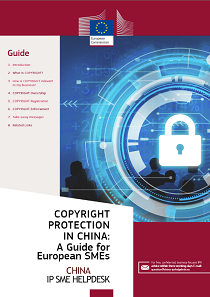
|
Guide to Copyrights in China A copyright protects intangible original intellectual creations in the fields of literature, art or science that can be reproduced in a tangible form from being reproduced without the permission of the copyright holder. Unlike trademarks and patents, registration of copyrights is not compulsory in order to obtain protection, but can help in proving the ownership of the copyright in the case of infringement. Download the full guide to learn more. |
|
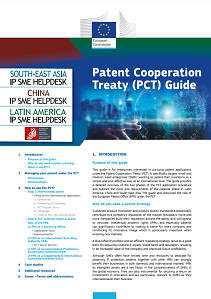
|
Patent Cooperation Treaty (PCT) Guide This guide is for enterprises interested in pursuing patent applications under the Patent Cooperation Treaty (PCT). It specifically targets small and medium sized enterprises (SMEs) wanting to patent their inventions in a simple and cost-effective way at an international level. The guide provides a detailed overview of the two phases of the PCT application procedure and outlines the costs and requirements of the national phase in Latin America, China and South-East Asia. The guide also discusses the role of the European Patent Office (EPO) under the PCT. |
|
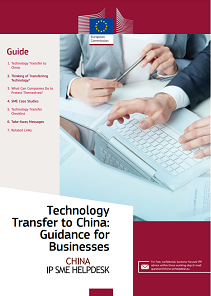
|
Technology Transfer to China: Guidance for Businesses Many European companies are keen to come to China. While in the past, European companies came to China to take advantage of low-cost manufacturing for export, more recently, they have come to enter the Chinese domestic market, establish R&D collaborations, engage in cooperative development, take advantage of a skilled work force, establish suppliers, and develop long-term partnerships in China. In order to achieve this, they are often willing to ‘transfer’ their key technology and designs to Chinese subsidiaries of European firms, joint-venture (JV) partners, or Chinese manufacturing and service companies. One of the challenges facing European companies coming to China is devising creative solutions to minimize the risk to their intellectual property (IP) associated with such technology transfers. |
|
|
|
How to Remove Counterfeit Goods from E-commerce websites This guide provides you with information on the regulations governing e-commerce and a practical introduction on how to have infringing products removed from the largest Chinese e-commerce platforms Alibaba, JD.com and Pinduoduo. In addition, an introduction of how to remove infringing products from social media apps such as WeChat is provided. |
|
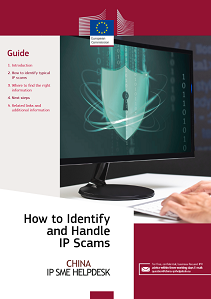
|
How to Identify and Handle IP Scams This guide provides EU SMEs with tips on how to recognise IP scams, where to find the correct information on IP services and what actions can be taken to avoid or mitigate scams. |
|
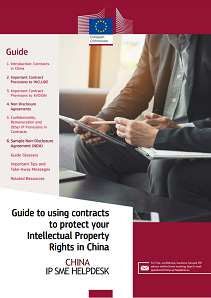
|
Guide to Using Contracts to protect your Intellectual Property Rights in China Tailoring contracts to suit your IPR is an important way to ensure that your company's specific intellectual property assets are adequately protected. This guide outlines some key contract provisions that you need to include in your agreements, important clauses that must not be used in China (because they could be in contravention of the Chinese laws thus rendering the contract void), how to protect confidential information through contracts, and protecting the ownership of new IP created in China). It contains a sample Non-Disclosure Agreement. |
|
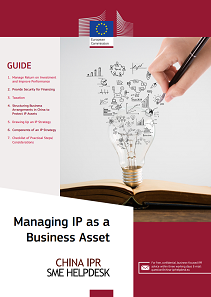 |
Guide on Managing IP as a Business Asset Understanding the financial value to the business of specific IP assets is of particular importance when moving into a new market – product or geographic – because there will be new risks as well as opportunities. China presents some special challenges and practical steps to protect the value of IP assets are often as important as legal ones. This guide aims to explain how IP assets matter from a financial perspective and assess how to manage them to the greatest business advantage. |
|
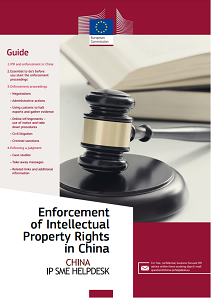
|
Enforcement of Intellectual Property Rights in China The intellectual property rights (IPR) available in China are very similar to those available in Europe. Assuming you have registered your IP and found it being infringed then you will want to enforce it. How will you find it being infringed? Your customers might tell you about competing products, you might find infringements for sale on the internet, you might see infringing products at a trade fair. |
|

|
Guide on How to record IPR with the Customs in China Unlike Europe, China has both imports and exports customs, which has the authority to seize IP infringing goods. Learn how to work with Chinese customs to protect your IPR and prohibit infringing goods from entering or leaving the country |
|
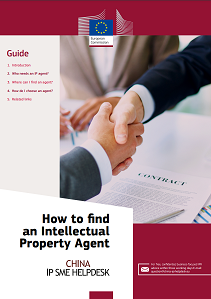
|
Guide on How to Find an Intellectual Property Agent Filing proper intellectual property (IP) registrations before you start doing business in China is essential in order to protect your company’s intangible assets and provide the ground work in case you need to enforce your rights in China. As an EU SME, if you plan to apply for a trade mark or a patent in China, you may be able to extend your domestic registrations to China or you may need to, or prefer to, register patents directly with the National Intellectual Property Administration (CNIPA) or trademarks with the Trade Mark Office of CNIPA. In either scenario, you may want to, or be required to hire a local professional IP agent or lawyer to do the registration on your behalf. In practice, where and how to find a good IP agent in China is a common concern for SMEs. This guide provides some basic guidelines, tips and sources on how to find a trade mark or patent agent and what to look out for when choosing the right agent for you. |
|
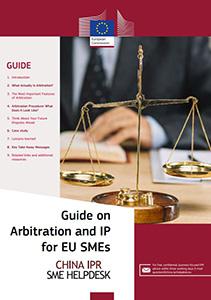 |
Guide on Arbitration and IP for EU SMEs Imagine a situation that you signed a licensing agreement with your Chinese business partner. At the beginning, all looks very promising, but after a few months, your business partner is not paying due fees for the use of the license. You are sending emails to urge the other party to pay immediately. That is, however, unsuccessful. You wonder what step to take next, and it seems that the only way is to go to a Chinese court to resolve this dispute. Yet, that does not have to be the only way to resolve your IP related disputes. This Guide introduces you to the use of an alternative way, arbitration, in the context of IP-related disputes with China. |
|
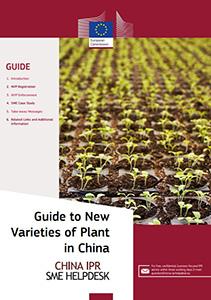 |
Guide to New Varieties of Plant New variety of plant (NVP), refers to improved plant varieties, cultivated or developed from wild plants discovered by breeders, which possess novelty, distinctness, uniformity and stability, as well as an adequate denomination. To acknowledge the special efforts and achievements made by the breeders in developing new varieties for agriculture, horticulture and forestry, the protection of NVP entitles the plant breeders the exclusive rights to use the variety for commercial use. |
|
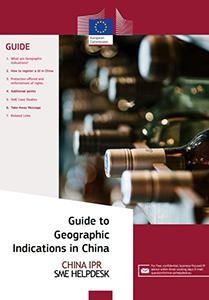 |
Guide to Geographic Indications in China ‘Champagne’ sounds better tasting than ’sparkling wine’, doesn’t it? What about ’Bordeaux wine’, ’Parma ham’ and ’Roquefort cheese’? You can practically taste them, right? Such specific origins that create an association with a product’s quality, reputation or other characteristics are called Geographical Indications(GIs). The market for imported foods in China is large and growing. If you intend to export products that come from a specific geographical region to China, obtaining a GI registration can provide the necessary proof of the product’s origin and can increase trust from domestic consumers. This guide will take you through the necessary steps in registering your GI. |
|
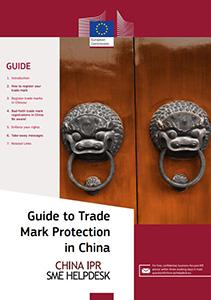 |
Guide to Trade Mark protection in China Until you register a trademark in China, you do not own that right, meaning that applying for a trademark before entering the China market is of utmost importance. This guide walks you through an overview of trademarks, how to apply for them and how to enforce your rights in case of an infringement. |
|

|
Guide on How to Conduct a Trade Mark Search Every company, no matter how big or small, has some IP. The most common type of intellectual property right (IPR) is a trade mark. A trade mark is essential to all kinds of companies, whether you are a producer, distributor or service provider, as it allows clients to distinguish you from your competitors and builds the image and reputation of your brand. Before you apply to register your trade mark in China you should check that it is available and has not been previously registered by another company, or is too similar to any other registered trade mark. This step will prevent you spending resources on an application which will be rejected and could delay your business operations in China. This guide is designed to Help you understand how to conduct a trade mark search on your own. |
|
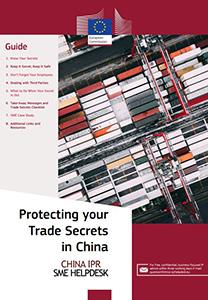 |
Guide to protecting your Trade Secrets in China A trade secret is any non-public information with actual or potential commercial value that is guarded by confidentiality measures. Trade secrets can ensure business advantage over competitors but must remain secret – once a trade secret becomes publicly known, it can no longer be protected as a trade secret. Most theft of trade secrets cases involve current or former employees. Download the full guide to learn more. |
|
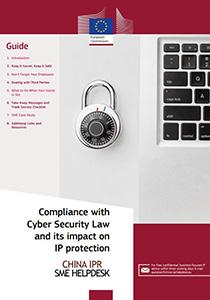 |
Compliance with Cyber Security Law and IP protection The Cyber Security Law of China (CSL) entered into force in 2016. It has significant implications with regards to data privacy and data transfer for EU SMEs doing business in China. This guide provides you with an overview of the CSL, its implications to data privacy and IP protection and offers SMEs tips on how to effectively protect their IP. |
|
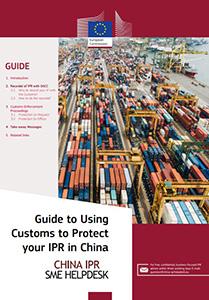 |
Guide to using Customs to protect your IPR Unlike Europe, China has both imports and exports customs, which has the authority to seize IP infringing goods. Learn how to work with Chinese customs to protect your IPR and prohibit infringing goods from entering or leaving the country. |
|
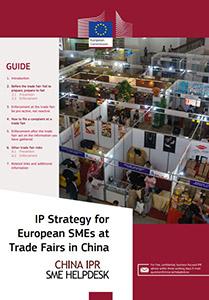 |
IP Strategy for SMEs attending Trade Fairs in China Trade fairs represent an opportunity to promote your products in China but also expose your IP to potential infringers. This handbook provides a step-by-step guide to intellectual property strategy and protection before, during and after a trade fair or an exhibition in China. |
|
|
|
Protecting your IP at Trade Fairs (China, India South-east Asia, Latin America) This guide provides an overview of Intellectual Property (IP) protection strategy for EU SMEs specifically on how to be ready before, during and after a trade fair or exhibition in China, South-East Asia and Latin-America. Trade fairs provide IP owners with the opportunity to present their innovations and ideas to potential business partners and customers. In addition, participation in exhibitions and trade fairs allows them to learn from and collaborate with other innovators. With the advent of increasingly integrated global-value chains and the continuous drive to innovate, trade fairs have become one of the most important and most efficient instruments for accessing new markets worldwide. From a prevention point of view, although attending a trade fair or exhibition can reap substantial benefits, SMEs should be aware of the possible IP risks that are implied. |
|
|
|
How to internationally protect your Trade Mark through the Madrid system? The ‘Madrid system for the international registration of trade marks’ is a cost-effective solution for registering trade marks worldwide. The system is administered by the International Bureau of the WIPO and allows trade mark owners to protect their marks in several countries by filing one application and obtaining an international registration that takes effect in each of the designated contracting parties. This guide will give you an overview about how the system works and what are the advantages and disadvantages. |
|
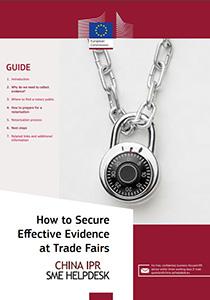 |
How to secure effective evidence at Trade Fairs? For many European SMEs, exhibiting at a major trade fair in China may be the first step towards internationalisation. However, as well as providing business opportunities, trade fairs also pose risks for exhibitors by exposing new products, technology, designs and brands to those who would copy the efforts of others for their own financial gain. This step-by-step provides you with practical advice on how to collect evidence of IP infringements at trade fairs in China. |
|
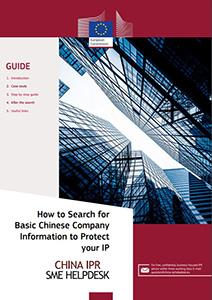 |
How to search for basic Chinese company information to protect your IP? When establishing business operations in China, finding local business partners and customers can be a major task. As well as the challenge of reaching out to a new business community, how can you have confidence in the honesty of your potential partners? How can you check that the company really has the scope and capabilities claimed? If you find out that your intellectual property in China has been infringed how can you start to research the infringer? This How-to guide will give you practical guidance on these issues. |
|
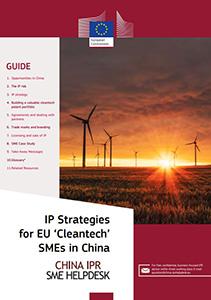 |
IP strategies for EU ‘Cleantech’ SMEs in China With a large potential clean technology market, and strong government support for the development and adoption of new clean technologies, China presents great opportunities for European cleantech SMEs. However, as the market becomes increasingly competitive, strategically managing, protecting and leveraging IP becomes even more essential. Understanding how IP fits into the overall strategy of your business in China can lead to more opportunities and conserve competitiveness. Download this guide to learn more. |
|
|
|
Guide to IPR protection in China for the Furniture Industry In China, the most prominent issue facing the furniture sector is the risk of copycats, either through design imitation and/or brand counterfeiting. The aforementioned growth in demand represents a challenge for the furniture industry as brands need to rapidly create new items with new styles and designs for interested consumers. The new models are then presented to the public, retailers and buyers during trade fairs or inside showrooms. At the same time, the increase of production causes the level of advertising and marketing communications to rise, through detailed catalogues, massmedia and online channels. This increase in production and communication activities augments the exposure of a brand and ultimately raises the risk of “copycats” of exclusive designs by competitors. In this regard, it is essential for industries operating in the furniture sector to develop a strategy to protect their intellectual property rights (IPR). |
|
|
|
IPR Guide for European businesses in the Ceramics Industry The European ceramics industry is diverse in terms of products, technology, and end-use, characterised by a large number of SMEs producing unique ceramic products. In recent years this industry has witnessed an influx of comparable low-cost ceramics products, sometimes copies of designs developed in the EU. A significant number of these ‘copied’ European-designed products are imported from China. As these imports increase, China’s system of intellectual property rights (IPR) protection and enforcement will play a more crucial role in helping European SMEs protect their products in their home markets. Defence of IPR can be a challenge and requires commitment to an integrated IPR protection strategy at home and in the country of origin of the infringements. SMEs that are not active in the domestic Chinese market and even those that do not have plans to enter this market in the future, still need to consider protecting and acquiring rights in China to stop imports at their source before they reach market countries. |
|
|
|
Guide to IPR protection for the Food & Beverage Industry China’s rapid growth has stimulated a taste for imported food and beverage (F&B) products among its consumers. Due to their reputation for quality, European F&B products (notably wine and spirits) are often the target of Chinese counterfeiters. It is therefore very important that European SMEs importing F&B to China take proactive measures to safeguard their intellectual property rights (IPR). This involves: understanding the Chinese trade mark system and the importance of registering both a European and a Chinese trade mark; protecting packaging styles using design patents; ensuring that copyrights are registered where required, and guarding trade secrets. This guide provides an overview of IPR issues that should be borne in mind in China, specifically in the F&B industry. |
|
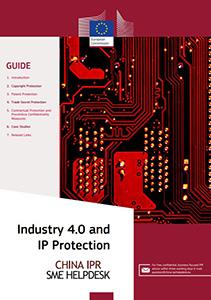 |
Industry 4.0 and IP protection Industry 4.0 technologies are transforming economies, jobs and even the society itself. The Chinese market is also affected by this change as the government plans to upgrade the manufacturing capacity of the Chinese industry into a technology powerhouse. Applying the traditional concept of IP to these new technologies can be difficult; this guide provides more information on how to protect and exploit IP for SMEs engaging in industry 4.0 technologies in China, including creation, registration and management of an IP portfolio. |
|
|
|
Guide to effective protection of IPR for the mechanical engineering sector As ‘the world’s factory’ China has a high demand for the machinery and tools required for manufacturing on a massive scale. In particular the demand for high quality and innovative products in the mechanical engineering sector makes China a great potential market for European manufacturers. This guide will provide a general overview of the way IP protection affects European SMEs in the field of mechanical engineering in China, highlighting the inherent dangers and providing an overview of the best preventive strategies and remedies against the most common China IP challenges. |
|
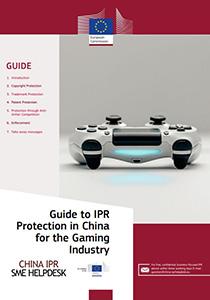 |
IP protection for the Gaming industry China’s gaming industry enjoyed a tenfold increase in revenue between 2008 and 2017, becoming the world’s largest gaming market in 2018. As a result, European SMEs are increasingly interested in expanding to China, although IPR infringements still represent a major concern. This guide provides an overview of IP protection in game development, helping EU SMEs deploy a comprehensive IP strategy when doing business with China. |
|
|
|
IP protection in China for the Fashion and Design industry This guide takes a practical look at the most relevant intellectual property rights (IPR) protection and enforcement in China (trade marks, design patents and copyrights) with a particular emphasis on issues and challenges for European small and medium size enterprises (SMEs) in the fashion and design industry. |
|
|
|
Guide to IPR protection in China for the Wine and Spirits sector Many EU SMEs are active in the wine and spirits industry. China has a thirst for EU wines and spirits, and with a market of more than 1.4 billion people it has great potential for EU SMEs. However, market entry also poses a risk in terms of brand protection. What can EU SMEs do to protect their wines and spirits in China? This guide will lay out the possibilities for intellectual property rights protection in the wine and spirits industry, and will guide you through IP enforcement options in China. |
|
|
|
Guide to Finding the Right Lawyer Hiring a lawyer is an important decision that should not be based solely upon advertisements or recommendations. An experienced and capable lawyer could not only strengthen your business’s IPR strategy but also effectively assist you in enforcing your IPR rights against infringers. To find a lawyer that can help you with your IPR in China, you should consider contacting the lawyer’s association in your country, the directory of lawyers maintained by your country’s embassy or chamber of commerce in China, or an online law firm directory. China IP SME Helpdesk also maintains a directory of lawyers it cooperates with. The directory is accessible via Helpdesk website. Be sure to establish the facts/ information about the problem before discussing with a lawyer. This will allow the lawyer to put the problem in context with the local laws and regulations. |
|
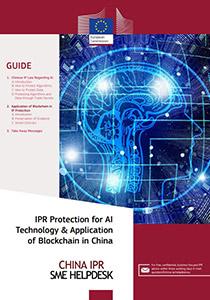 |
IPR protection for AI technology & application of Blockchain in China Artificial Intelligence (AI) and Blockchain are among the most important and potentially revolutionary technological advancements of the 21st century, playing a major role in industries ranging from automated driving to language and speech recognition. This guide provides European SMEs with knowledge on how AI is protected by IP laws in China, outlining how to protect data through copyright, patent and trade secrets. It also gives an overview of legal opportunities provided by blockchain, and the use of blockchain in Chinese courts. |
|
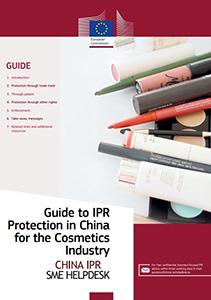 |
Guide to IPR protection in China for the cosmetics industry In recent years, due to the expansion of China’s middle class, increased interest in personal care has led to the rapid development of the cosmetics industry. In addition, the adjustment of the tariff system in China and the rise of e-commerce platforms such as Taobao, Jingdong and Pinduoduo contributed to the sales of cosmetics products. The industry shows an annual growth of 12.6% and in 2019. |

